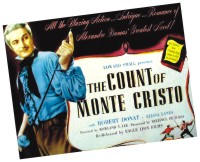|
Classic Corner
The Count of Monte Cristo
By Alexandre Dumas
The Count of Monte Cristo (French: Le comte de Monte Cristo) is a classic adventure novel by Alexandre Dumas. It is often considered, along with The Three Musketeers, as Dumas' best work, and is frequently included on lists of the best novels of all time.
 Dumas got the idea for The Count of Monte Cristo from a true story, which he found in a memoir written by a man named Jacques Peuchet. Peuchet related the story of a shoemaker named Pierre Picaud, who was living in Paris in 1807. Picaud was engaged to marry a rich woman, but four jealous friends falsely accused him of being a spy for England. He was imprisoned for seven years. During his imprisonment a dying fellow prisoner bequeathed him a treasure hidden in Milan. When Picaud was released in 1814, he took possession of the treasure, returned under another name to Paris and spent ten years plotting his successful revenge against his former friends. Dumas got the idea for The Count of Monte Cristo from a true story, which he found in a memoir written by a man named Jacques Peuchet. Peuchet related the story of a shoemaker named Pierre Picaud, who was living in Paris in 1807. Picaud was engaged to marry a rich woman, but four jealous friends falsely accused him of being a spy for England. He was imprisoned for seven years. During his imprisonment a dying fellow prisoner bequeathed him a treasure hidden in Milan. When Picaud was released in 1814, he took possession of the treasure, returned under another name to Paris and spent ten years plotting his successful revenge against his former friends.
The novel begins with Edmond Dantès, a 19-year-old sailor aboard the ship Pharaon, who is returning to his home in Marseille. Dantès is experiencing a mix of emotions. He is excited to be reunited with his family and friends, and he is eager to marry his fiancée, the Catalan beauty Mercédès. Dantès' good fortune inspires jealousy in the hearts of those he considers his friends, because it seems to impede their ambitions in power, money, and love.
The plot is based around a letter that Danglars had seen the dying Captain Leclère secretly give to Dantès. Danglars had known of Leclère's loyalties to the exiled French Emperor, Napoléon, and so he pieces together the final wish of the captain: to deliver a letter to a Bonapartist. With this in mind, he calls on Fernand to dine with him and Caderousse. Enciting jealousy from the young man who is in love with Mercédès, Danglars crafts a letter to M. Villefort, the crown prosecutor in Marseille, indicating Dantès as a Bonapartist, citing as proof a letter they will find on his person, or in his personal belongings.
 Villefort, spurred to action by the anonymous tip, investigates the matter and indeed finds the letter. Dantès knows nothing of the contents of the letter, only that he was supposed to deliver it. Although at first sympathetic to Dantès' case, when Villefort finally reads the incriminating letter, he discovers that it is addressed to his own father, Noirtier de Villefort. Due to the restoration of the King, Villefort wants to distance himself from his Bonapartist father in the current political climate. Villefort realises that the letter could endanger all his future plans. While he knows that he could simply make the letter disappear, he also knows that Dantès would be a loose thread that could threaten him in the future. Although Villefort would rather not imprison an innocent man, he ultimately chooses his own future over that of Dantès, and condemns him to a life sentence in the Château d'If prison. Finally Dantès escapes from the prison. His revenge begins. Villefort, spurred to action by the anonymous tip, investigates the matter and indeed finds the letter. Dantès knows nothing of the contents of the letter, only that he was supposed to deliver it. Although at first sympathetic to Dantès' case, when Villefort finally reads the incriminating letter, he discovers that it is addressed to his own father, Noirtier de Villefort. Due to the restoration of the King, Villefort wants to distance himself from his Bonapartist father in the current political climate. Villefort realises that the letter could endanger all his future plans. While he knows that he could simply make the letter disappear, he also knows that Dantès would be a loose thread that could threaten him in the future. Although Villefort would rather not imprison an innocent man, he ultimately chooses his own future over that of Dantès, and condemns him to a life sentence in the Château d'If prison. Finally Dantès escapes from the prison. His revenge begins.
Read the novel to find out what happens to Dantes and his enemies.
Copyright
(R) thedailystar.net 2006 |
